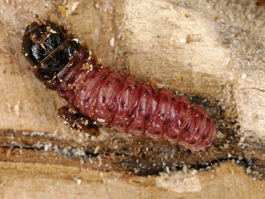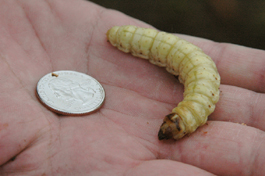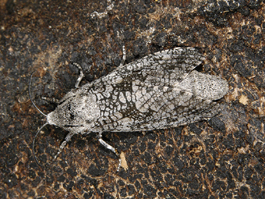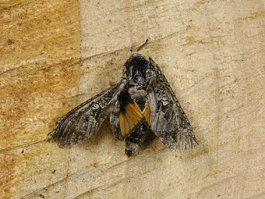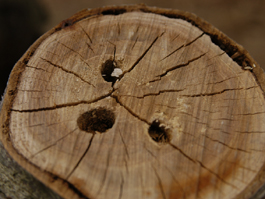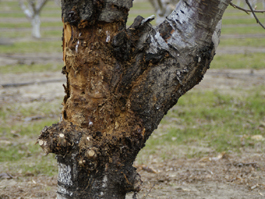by Eugene R. Hannon and Elizabeth H. Beers, published online December 2007
Prionoxystus robiniae Peck (Lepidoptera: Cossidae)
The carpenterworm (Prionoxystus robiniae Peck) is native to North America. Riparian habitats and poplar windbreaks provide suitable host plants in the Pacific Northwest. Trees are damaged when larvae bore into the trunk. Older trees with some form of prior injury are more susceptible to attack.
Carpenterworm is a relatively uncommon pest in Washington orchards, although it is quite damaging in poplar trees grown for pulp. There were a few reports in the mid-1960s of damage to sweet cherry in Washington. In 2005-06, active infestations were found near Wenatchee, Buena, and Pasco (all in sweet cherry), although the infestations were limited to a few scattered trees only.
Hosts
Carpenterworm feed on a variety of deciduous trees including oak, birch, ash, black locust, elm, maple, willow, cottonwood, pecan, and less commonly on fruit trees such as cherry, peach, pear, and apricot.
Life Stages
Egg
The egg is grayish green, oval, and ca. 1 mm in diam. Eggs are laid in clusters of up to 200 eggs in bark crevices. The appearance of larvae varies with age and sex.
Larva
Early instar larvae tend to dark reddish, while medium-sized larvae are pinkish. Large male larvae are pinkish to creamy brown, and about 5 cm long. Large female larvae are greenish white and ca. 7.5 cm long.
Pupa
The pupa is naked (no cocoon) and fully sclerotized. Female pupae are 3.8 to 5 cm long, while the smaller male pupae are ca. 2.5 cm long.
Adult
The adult is a large, robust moth with mottled gray and black forewings. Females are 3.8-5 cm long, with a wingspan of 7.5 cm. The males (only) have orange hindwings, and are smaller than the females (2.5 cm long, wingspan 5 cm). The coloration of the adults is cryptic when they are resting on the tree bark. Older moths tend to lose some scales, giving them an oily appearance.
Life History
Carpenterworm takes 2-4 years to develop in northern climates (such as the Pacific Northwest), but can complete its development in 1 year in the southern part of its range. There is only one flight per year, from late April to early August, with a peak in late June. Females attract males with a pheromone, for which a commercial lure is available. The females mate shortly after emerging, and live only a few days. The first clutch of eggs is usually laid on the larval host tree, and dispersal to a new host may occur after that. Eggs hatch in ca. 2 weeks, and neonates bore either into the tree near the oviposition site, or may disperse to another area on the tree. The larvae bore into the heartwood of the tree, pushing frass and excrement out of the entrance hole. The tunnels are enlarged steadily as the larva grows. The larvae have a minimum of 8 instars, but can go through up to 30 instars. Unlike most Lepidoptera, carpenterworm larvae may undergo stationary molts until the correct trigger for pupation occurs. The larvae pupate near the gallery exit, and the exuvia may be found protruding from the exit hole. This species overwinters as larvae.
Damage
The tree is weakened structurally by the large tunnels in the heartwood and may snap off during windy conditions. In tree species grown for lumber, the quality of the resulting lumber is degraded by tunnels. Other insects and pathogens may gain entrance to the tree through the holes made by the larvae, and further weaken the tree. Woodpeckers digging in the trunk for carpenterworm may exacerbate the original damage.
Biological control
Two species of entomophagous nematodes (Steinernema carpocapsae Weise and S. feltiae Bovien) are effective control agents. Nematodes can be injected directly into the galleries. An ichneumonid parasitoid (probably Lissonota sp.) has been found attacking carpenterworm larvae in the Pacific Northwest, but the degree of suppression by this wasp is uncertain.
Monitoring
The flight of adult males may be monitored with a commercial pheromone lure in bucket or large Delta traps. Flight is affected by wind and temperature, and a degree-day model is available to predict flight events. Males are strong flyers, and may be lured to a trap from a considerable distance, thus trap catch alone is not an indication of damage to trees in the immediate vicinity. Riparian areas or Lombardy poplar windbreaks are common sources of males. Direct evidence of damage in the lower trunk area (sawdust-like frass, pupation sites is necessary to locate an infestation, and typically a destructive sample of the tree must be taken to obtain larvae for identification.
Management
Because flight period is so long, targeting adults with insecticides is impractical. Mechanical control (inserting a wire into the gallery to kill the larva) is feasible if only a few trees are affected. Because a pheromone is available, mass-trapping or mating disruption may be possibilities, but to date have not been proven as viable techniques for carpenterworm. The best management strategy currently is prevention. Winter-injured or mechanically injured trees are more susceptible, so keeping trees healthy and vigorous will help prevent carpenterworm from becoming established. Tree removal may be the best course for extensively damaged trees.
References
Doolittle, R. E., W. L. Roelofs, J. D. Soloman, R. T. Card, and M. Beroza. 1976. (Z,E)-3,5-Tetradecadien-1-ol acetate sex attractant for the carpenterworm moth, Prionoxystus robiniae (Peck) (Lepidoptera: Cossidae). J. Chem. Ecol. 2: 399-410.
Faccioli, G., E. Pasqualini, and P. Baronio. 1993. Optimal trap density in Cossus cossus (Lepidoptera: Cossidae) mass-trapping. J. Econ. Entomol. 86: 850-853.
Forschler, B. T., and G. L. Nordin. 1988. Suppression of carpenterworm, Prionoxystus robiniae (Lepidoptera: Cossidae), with the entomophagous nematodes, Steinernema feltiae and Steinernema bibionis. J. Kansas Entomol. Soc. 61: 396-400.
Forschler, B. T., and G. L. Nordin. 1989. Techniques for rearing the wood borers Prionoxystus robiniae (Lepidoptera: Cossidae) and Paranthrene dollii (Lepidoptera: Sesiidae). Fla. Entomol. 72: 224-226.
Geisel, P. M. 2003. Carpenterworm. Publications 74105, University of California IPM, Davis, CA.
Hay, C. J. 1968. Frass of some wood-boring insects in living oak (Coleoptera: Cerambycidae; Lepidoptera: Cossidae and Aegieriidae). Ann. Entomol. Soc. Amer. 61: 255-258.
Soloman, J. D. 1988. Infuence of host on larval survival, feeding habits, and adult fecundity of the carpenterworm (Lepidoptera: Cossidae). J. Econ. Entomol. 81: 834-839.
Solomon, J. D., and C. J. Hay. 1974. Annotated bibiography of the carpenterworm, Prionoxystus robiniae. General Technical Report SO-4, USDA Forest Service,
Solomon, J. D., and W. W. Neel. 1972. Emergence behavior and rhythms in the carpenterworm moth, Prionoxystus robiniae. Ann. Entomol. Soc. Amer. 65: 1296-1299.
